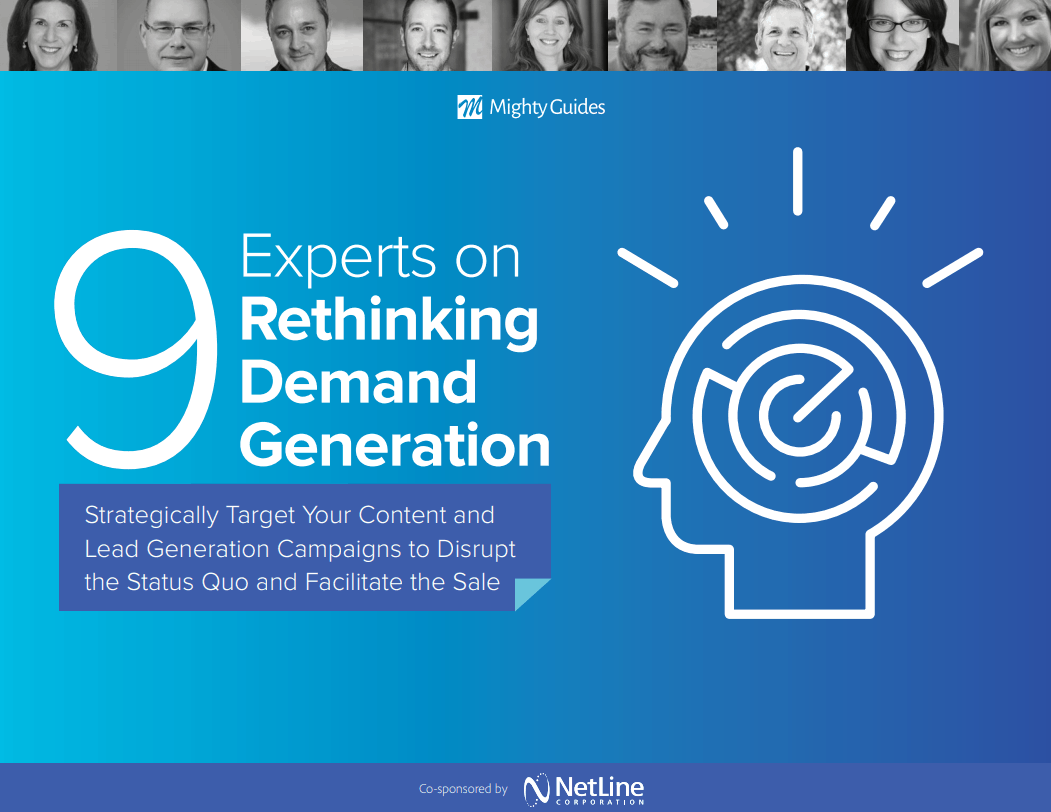
Tim Riesterer, Chief Strategy and Marketing Officer, Corporate Visions
FIND YOUR DISRUPTIVE STORY
- To defeat status quo thinking, you must move beyond “voice of the customer” research.
- Unconsidered needs must prove the argument you make about the high cost of not making a change; map these needs directly to valuable capabilities of your solution.
- Introduce uncertainty about unconsidered needs—a story that shows the size, speed, and high cost of these problems about which the prospect may be completely unaware and illequipped to handle.
“Demand gen messaging must deliberately address the causes of status quo thinking.”
For marketers, one of the toughest challenges is breaking the status quo bias that persists at companies everywhere. Overcoming that challenge requires a disruption of the status quo. Demand generation content can play a key role in overcoming this bias, but it often fails to deliver the needed disruption. In fact, marketing messages too often serve only to strengthen status quo bias. “The reasons why people stick with the status quo are well known,” says Tim Riesterer, an expert in helping companies find their stories. “Demand gen messaging must deliberately address the causes of status quo thinking.”
Riesterer lists four reasons why people stick with the status quo:
1. People prefer to keep their current preferences stable. To overcome their mindset, you must destabilize their preferences. “You have to introduce uncertainty into their preferences before they’re even open to persuasion,” Riesterer says.
2. Perceived cost of change. People believe that their status quo is free because it’s already factored into their budget. They think that change must come with all kinds of costs—in the form of money, resources, and added stress just to get a consensus decision. Riesterer says, “You have to tell a story that shows the high cost of staying the same. People usually skip that and go right to return on investment or total cost of ownership. If you’re selling against something the customer believes is free, though, those benefits mean nothing.”
3. Selection difficulty. When solution providers are all selling against what people are doing today, their pitches start to sound the same. Making a choice becomes difficult. “Your story must emphasize the contrast between what’s being done today and what you’re offering for tomorrow,” says Riesterer.
4. Anticipated regret and blame for a decision. Buyers are afraid of being blamed for a decision that goes bad or results in unexpected complications and second-guessing. They need to know that somebody else had success before them—somebody like them who started in a similar state and moved to the future state successfully.
To defeat status quo thinking, begin by moving beyond “voice of the customer” research. When everybody is identifying a similar set of needs and concerns among prospects, the result is a similar portfolio of solutions. Riesterer says, “If everybody is answering the same needs with a similar set of solutions, the customer doesn’t see enough contrast. Even though you’ve identified problems, they are problems the customer already knows about because they’ve already told you. You’re simply confirming what they already know. Your message is not disruptive enough to dislodge the status quo.”
To get beyond voice of the customer, introduce unconsidered needs— that is, needs, problems, challenges, and missed opportunities that customers haven’t identified and that you can relate to the unique qualities of your offering. By introducing unconsidered needs, you also introduce uncertainty about the status quo and the possibility that they missed something important. “You need both uniqueness and uncertainty in your message,” says Riesterer. “Uniqueness means that you’re saying something different from everyone else; uncertainty is about unconsidered needs, which are the things that will disrupt what they’re currently doing.”
Unconsidered needs must prove the argument you make about the high cost of not making a change; they must map directly to the valuable capabilities of your solution. So, how do you build those special unconsidered needs into your story? First, you cannot introduce unconsidered needs that your solution doesn’t address. If you introduce risk and uncertainty without a solution to them, you will only make the customer angry. Similarly, you can’t introduce your unique capabilities as value-added features beyond the core features that your product (and everyone else’s) has. Riesterer says, “Customers don’t see value-added features as adding value. They see them as adding cost and complexity.” Of course, these very elements make your offering unique.
You must begin with some reverse-engineering to map your product’s unique features to customer needs. Then, build your story backwards to introduce uncertainty about those unconsidered needs—a story supported by data showing the size, speed, and high cost of these problems about which the prospect may be completely unaware and ill-equipped to handle. Then, show how your product addresses that problem in a unique way, how different and improved the prospect’s operation will be with your product implemented, and how other, similar businesses have succeeded with your solution.
“You have to lead with disruption,” Riesterer explains. “If you lead with things they already know, their brain locks in that certainty, and you’ll have a difficult time dislodging it. For the most persuasive impact, first show them the unconsidered thing, the thing they didn’t know.”



